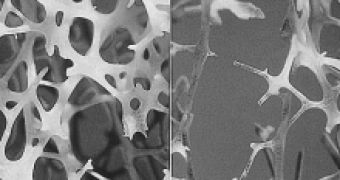Osteoporosis is a disease which makes bones become fragile and more likely to break. Eventually, without following any treatment, it can progress virtually without pain until a bone breaks, frequently bones in the hip, spine, and wrist. The disease is called silent because people may not know that they have osteoporosis until a sudden strain, bump, or fall causes a bone to break. Among the most dangerous are hip fracture, which requires hospitalization and major surgery and spinal or vertebral fractures, which lead to loss of height, severe back pain, and deformity.
Only in the United States, 10 million people already have osteoporosis. Millions more have low bone mass, which increases the risk for more serious bone loss and subsequent fractures. Of these 10 million, about 80% are women, who have a higher risk of suffering from the disease. Even if osteoporosis is often thought of as an older person's disease, it can strike at any age. For women, the rate of bone loss increases for several years after menopause, then slowing down. In men, the bone loss occurs more slowly. But by age 65 or 70, most men and women are losing bone at the same rate.
For a person who suffers from weakness in the bones, a sudden strain, bump, or simple fall can cause a fracture or a break. 50% of women and 25% of men will have an osteoporosis-related fracture in their lifetime, osteoporosis being held responsible for more than 1.5 million fractures annually, among which 300,000 hip fractures, 700,000 vertebral fractures, 250,000 wrist fractures and 300,000 fractures of other bones.
Osteoporosis shows no symptoms and people become aware of it only when a simple fall causes a major fracture. It might even lead to collapsed vertebrae, which results in severe back pain and deformities such as kyphosis or stooped posture.
Women and men who have had a fracture are at high risk of experiencing another one. A fracture over the age of 45 may be a warning sign that a person has already developed osteoporosis. People over the age of 45 who have experienced a fracture should talk to their doctor about getting tested for osteoporosis.
There are some factors which increase the risk of developing osteoporosis, such as personal history of fracture after age 50, current low bone mass or history of fracture in a relative of the first degree. For a female being old in age, the estrogen deficiency as a result of menopause or low testosterone levels in men, deficiency of vitamin D, low intake of calcium throughout one's life, cigarette smoking and excessive use of alcohol might also increase the risk of developing the disease.
Tests which measure the bone mineral density can determines the rate of bone loss and/or monitors the effects of treatment. An increase of these tests was associated with a decrease in hip fractures. Visits for osteoporosis have increased during the last 10 years, 1.3 to 6.3 million.
Building strong bones during childhood, until the age of 20, can be the best defense against the disease. Also, a balanced diet rich in calcium and vitamin D, exercises including weight lifting and resistance, no smoking or excessive alcohol intake and bone density testing and medication when appropriate will drastically reduce the risk.
Although there is no cure for osteoporosis, the disease can be treated. Endocrinologists, rheumatologists, geriatricians, and internists are among the specialists who can provide care to people with osteoporosis. Approved drugs for the treatment of osteoporosis work, but also carry side effects.
Bisphosphonates slow bone loss, reduce fracture risk, and in some cases increase bone density by decreasing the activity of bone-dissolving cells. If not taken according to the prescription, they can cause serious digestive problems. A few people have muscle, bone, or joint pain while using these medicines.
Estrogen is also part of the approved drugs for the treatment of menopausal women. Still, it has been shown that the substance increases the risk for breast cancer, strokes, blood clots, and risks for heart attacks may be increased in some women who take estrogen, so only women at significant risk for osteoporosis should take it for a short period of time. Raloxifene also slows bone loss and reduces the risk of fractures in the spine, among the side effects being included hot flashes and an increased risk of blood clots in some women, while the parathyroid hormone is approved for the treatment of osteoporosis in men who are at high risk of fracture.

 14 DAY TRIAL //
14 DAY TRIAL //